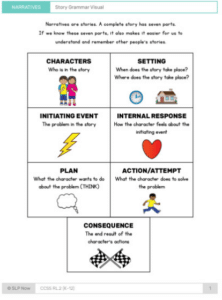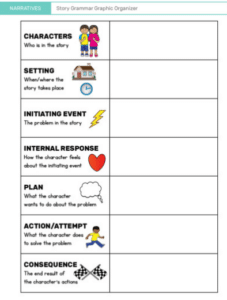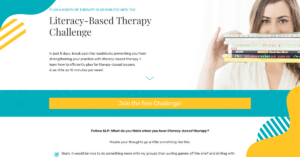Listen on Apple Podcasts Listen on Spotify
We are continuing with our new podcast series, Strategies You Can Use! I’ve been sharing different evidence-based strategies to help target specific skills.
Today I’ll discuss different strategies on how to target narratives!
4 Strategies to Target Narratives
✨Before we dive into the 4 strategies, I wanted to provide some evidence to get you excited about targeting narratives✨
✓Teaching story grammar has been found to improve comprehension from elementary students with learning disabilities to high school students (e.g., Gurney et al., 1990)
Gurney, D., Gersten, R., Dimino, J., & Carnine, D. (1990). Story grammar: Effective literature instruction for high school students with learning disabilities. Journal of Learning Disabilities, 23(6), 335–342.
✓ Explicit instruction on these elements provides children a framework (Hayward, Gillam, & Lien, 2007; Lynch et al., 2008).
✓ This helps “make language-learning tasks less demanding, more meaningful, and more authentic” (Tomasello, 2003).
1. Provide visual supports.
“Narrative instruction should include explicit teaching of story grammar elements” using graphic organizers and/or visual cues (Gillam et al., 2014).
Gillam, S. L., Olszewski, A., Fargo, J., & Gillam, R. B. (2014). Classroom-based narrative and vocabulary instruction: Results of an early-stage, nonrandomized comparison study. Language, Speech, and Hearing Services in Schools, 45, 204–219.

🍎 Use the SLP Now Story grammar elements! This is included in your SLP Now Membership.
✓The use of visuals and graphic organizers also enhances student comprehension (Paris & Paris, 2007).
Paris, A. H., & Paris, S. G. (2007). Teaching narrative comprehension strategies to first graders. Cognition and Instruction, 25(1), 1–44.

🍎 Use the SLP Now graphic organizer! This is included in your SLP Now Membership.
2. Identify story grammar elements.
Students can then identify story grammar elements in stories, which has been shown to yield improvements in complexity and content of oral narratives (Hayward & Schneider, 2000).
Hayward, D., & Schneider, P. (2000). Effectiveness of teaching story grammar knowledge to pre-school children with language impairment: An exploratory study. Child Language Teaching and Therapy, 16, 255–284.
Teaching story grammar also enhances student comprehension (Paris & Paris, 2007).
3. Identify missing elements.
Hayward & Schneider (2000) also found that identifying missing elements in stories yielded improvements in student narratives.
✓Try modeling the story and leave elements off so the student can correct you.
4. Use an authentic context.
Teaching story grammar in the context of authentic stories (e.g., books, fiction articles) yielded clinically significant improvements in students’ oral narratives (Swanson, Fey, Mills, & Hood, 2005).
Swanson, L. A., Fey, M. E., Mills, C. E., & Hood, L. S. (2005). Use of narrative-based language intervention with children who have specific language impairment. American Journal of Speech-Language Pathology, 14, 131–143.
✨ Putting it Together (Ukrainetz, 2007)✨
✓ Brainstorm parts of the story, and assess initial knowledge of story grammar (What do you need the beginning/middle/end?)
✓Introduce terminology for the story grammar elements using the graphic organizer
✓ Introduce the book (show the cover, read the title)
✓ Students guess what the story might be about + fill in the organizer
✓ Read the story + fill in the organizer
✓Compare predicted story + actual story
✓ Retell the story
Ukrainetz, T.A. (2007). Assessment and intervention within a contextualized skill framework. In T.A. Ukrainetz (Ed.), Contextualized language intervention: Scaffolding preK-12 literacy achievement (pp. 59-94). Austin, TX: PRO-ED.
Need goal ideas for targeting Narratives?
🎯 Check out SLP Now Goal-bank for some inspiration
Additional Links
Interested in any of the materials mentioned in this podcast? Join our Free 14 day SLP Now Trial Your first 5 downloads are on us!
Narrative Bundle – Story Grammar Icons + Graphic Organizer – Included in the SLP Now Membership
Next Up in this Pod Series
7/5/22 Strategies You Can Use: Following Directions
7/12/22 Strategies You Can Use: Grammar
7/19/22 Strategies You Can Use: Syntax
8/2/22 Strategies You Can Use: Basic Concepts
8/9/22 Strategies You Can Use: Basic Concepts
8/16/22 Strategies You Can Use: Affixes
8/23/22 Strategies You Can Use: Narratives
8/30/22 Strategies You Can Use: Summarizing
Subscribe & Review on iTunes
Are you subscribed to the podcast? If you’re not, subscribe today to get the latest episodes sent directly to you! Click here to make your listening experience auto-magic and as easy as possible.
Bonus points if you leave us a review over on iTunes → Those reviews help other SLPs find the podcast, and I love reading your feedback! Just click here to review, select “Ratings and Reviews,” “Write a Review,” and let me know what your favorite part of the podcast is.
Thanks so much!
Transcript
Marisha: Hello there and welcome to the SLP Now Podcast, where we share practical therapy tips and ideas for busy speech language pathologists. Grab your favorite beverage and sit back as we dive into this week's episode.
Marisha: Hey, there it's Marisha and welcome to the SLP Now Podcast. This summer we are doing a series called, Strategies You Can Use and we picked different goal areas, and we're going to do a blitz of three evidence backed strategies that you can use when targeting those specific skills. So these are mostly strategies that have come from the literature, and we're just pulling out the ones that are most practical, that might help you if you're feeling stuck or just wanting to try some new strategies when targeting some of our most common goals. So without further ado, lets dive right in.
Marisha: Today's episode is all about narratives and I've done a lot of research on narrative-based therapy over the years and so I have a lot of different references that I am pulling together, that have really informed how I approach this. So it's a little different than the other episodes, but I hope it'll be jam packed with tons and tons of information that you can use, including those practical strategies to target those goals in therapy.
Marisha: So first, before we dive into the specific strategies, I think it's helpful to talk about why we even want to teach story grammar in terms of narrative-based intervention and there's some really cool studies out there. So teaching story grammar has been found to improve comprehension and they've found this with elementary students who have learning disabilities and even with high school students. So there's an article by Gurney et al. in 1990, that looks at using this as an approach with high school students who have learning disabilities and how it even improves comprehension of a lecture. So it can really help with that generalization and impact students in the real world, in their context of the classroom and all of that.
Marisha: By teaching story grammar elements explicitly, it provides children with a framework and that's why they're able to generalize that. So they have that framework on how to analyze the information and how to make sense of that information that they're taking in, which in turn can help comprehension. The framework also helps make language learning tasks less demanding, more meaningful, and more authentic, and that comes from Thomas Ello in 2003. So, like I said, I'm just mentioning a couple of the citations here, but feel free to check out the show notes for this episode for the full reference list. You can find that at SLPnow.com/132. So, SLPnow.com/132.
Marisha: Now that we have a little bit of a framework in terms of why we even want to target this, I have a couple of strategies. So I'm going to share four evidence-backed strategies that we can use and then we're going to wrap things up and share what this could look like in terms of a whole unit or in a progression of a session. So the first strategy is to provide visual supports. So Gillan et al. in 2014 had a really nice article in the language speech and hearing services in schools journal. They say that narrative instruction should include explicit teaching of story grammar elements, and we can use graphic organizers and/or visual cues to do that. There are studies showing that the use of visuals and graphic organizers enhances student comprehension. So one example is that is from Paris and Paris in 2007.
Marisha: So for me, this includes some of the visuals that I use. I have some laminated story grammar icons, so I just have one icon on a laminated card. And so there's a set of seven icons and the back is blank. So I can use just the icons as cues, or if students need more support, we can use dry erase marker to do quick pictography for each element on the back. And then as we're practicing retelling the story, we can work on sequencing it, or I can just show them the icon when they're retelling, if they need some more support, I can flip the card around. It's a really fun activity and we can use those cards to identify story grammar elements. We'll give more examples of that going forward.
Marisha: And then my other go to support is a graphic organizer that also has the icons on it. Mine is also dry erase laminated. And I think this is nice when we're first teaching it because students can see that progression. And I feel like that's the most scaffolded way to do it. And then as they become more independent, we can just queue with individual cards. But those are two examples of visual supports that I like to use. The next strategy is to identify story grammar elements. I talked about this in the previous step, but we can do this in conjunction with visuals or not, but having students identify story grammar elements in stories has shown to yield improvements in the complexity and the content of oral narratives.
Marisha: One specific citation is from Hayward and Schneider in 2000 and they looked at the effectiveness of teaching story grammar knowledge to preschool children. So we've touched on articles from preschool, elementary, secondary. So this is a very worthwhile skill to target across the age ranges. So by teaching them to identify those story grammar elements, if we're going through a story, we can use the icons to identify the characters. And if we look at the first page, we can have the character icon and then identify, oh, who's the character. And then the next icon card is the setting, when and where does the story happen? And we can point to that and use the icons as a support as we're going through the book. Or we can fill in a graphic organizer as we're reading the book and identifying the parts of the story that way. So that is step two, identifying story grammar elements.
Marisha: The third strategy is to identify missing elements. So that same study by Hayward and Schneider in 2000 also found that identifying missing elements in stories yielded improvements in student narratives. So when I use this, I might model retelling a story and have the students make sure that I have all the elements and as they get more familiar with it, and as they get better at identifying the elements, I might leave elements off on purpose. And there are also a lot of stories that don't have all of the elements so we can work on identifying them that way as well. And then it can be a fun activity to do if you're working with a group of students. We can identify if our peers are leaving off elements, but we definitely want to have set that up appropriately to make sure that is done in a safe way.
Marisha: The fourth and last strategy is to use an authentic context. So we want to be teaching story grammar in the context of authentic stories, whether it's books or fiction articles or in terms of their own narratives. In the context of those authentic stories, we see a lot more clinically significant improvements. And this is from Swanson et al. in 2005. And they looked at the use of narrative-based language intervention with children who have SLI. So having that authentic context can really help with that generalization and make this a more meaningful activity.
Marisha: So just to recap the four strategies, really quick. One, we want to provide visual supports. The examples that I shared are the story grammar icon cards with one icon on each card or a story grammar organizer that has all of the story grammar elements in sequence so that they can view that. Then another activity is to identify story grammar elements when we're reading. The third strategy is to work on identifying missing elements in stories or retells. And then the fourth strategy is to use an authentic context. So using authentic stories from books or fiction articles, things that are relevant to the curriculum or narratives from their own lives.
Marisha: So, that's a recap of the four strategies. Dr. Ukrainetz has a fabulous textbook on contextualized language intervention and her chapter detailing how this could all be put together was really helpful. So what she shares is that first we brainstorm the parts of the story. So we might just look at the cover and a couple pages and then talk about who the characters might be, what the setting might be, and do a little bit of an inferencing activity. And if this is more towards the beginning, we can use this as a way to assess initial knowledge of story grammar.
Marisha: Do the students know what the parts of a story are? And what does that look like? And if they're not familiar with that, we can introduce the terminology for those story grammar elements, like using the icons or the graphic organizer. And I think if I was starting off, I would just use the graphic organizer because it helps keep the sequence straight. That's one less thing that they have to remember. But then once we introduce the terminology, we would introduce the book, look at the cover, read the title. And then we work on filling in that organizer, as the students are guessing what the story might be about and then reread the story and fill in the organizer with what actually happened. And if you have multiple organizers, that can be a really nice way to compare and contrast. So we can look at the predicted story and the actual story, and then we can work on retelling the story. So that's just an example of what a sequence could look like and putting those different strategies together. And yeah, that's a wrap.
Marisha: So join us next week for strategies on how to target summarizing, super excited to dive into that skill. As we move from narrative text to expository text, which is super relevant for our older students, as we move through the curriculum. We're reading expository texts even from early elementary. If your students are rocking narrative intervention, and they've got their story grammar elements down, this is a really, really great area to explore as well. So we'll see you next week.
Marisha: Thanks for listening to the SLP now podcast. If you enjoyed this episode, please share with your SLP friends and don't forget to subscribe to the podcast to get the latest episode sent directly to you. See you next time.
Sign up to receive email updates
Enter your name and email address below and I'll send you periodic updates about the podcast.




Reader Interactions